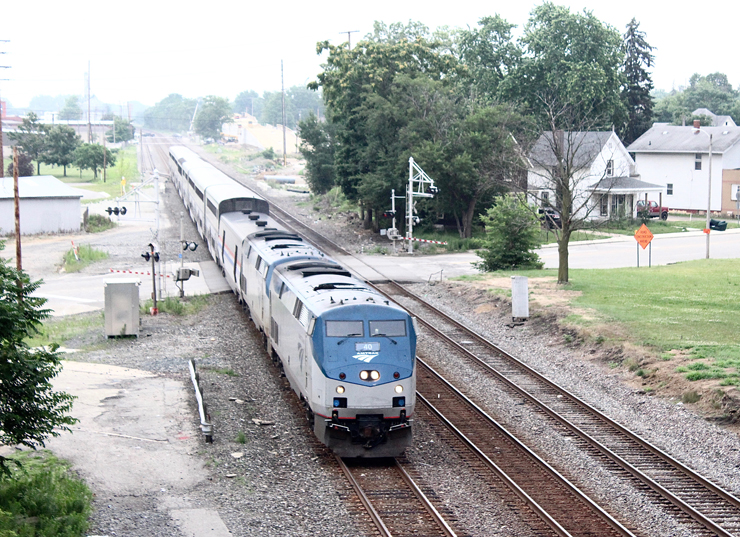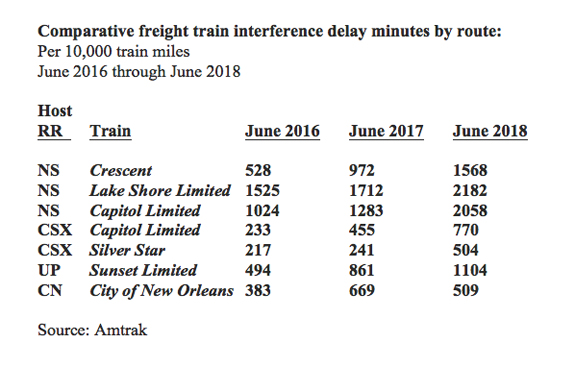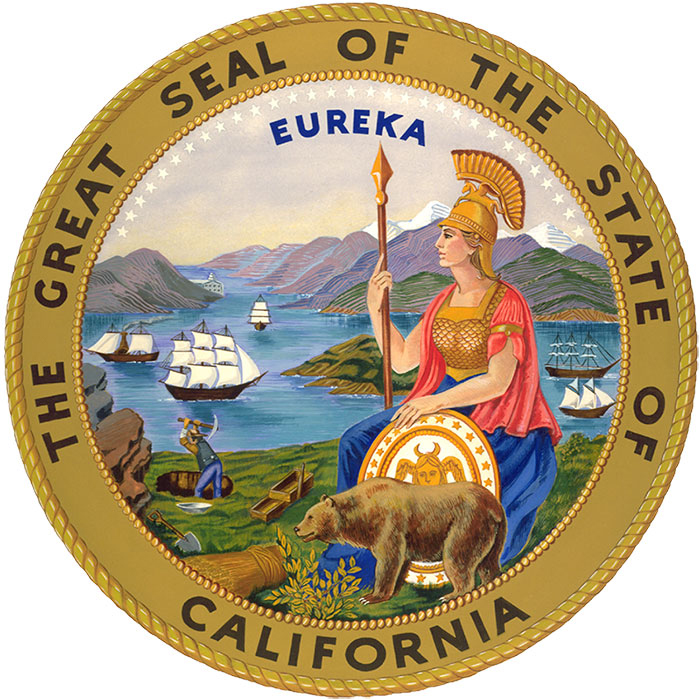CHICAGO — Host railroads and Amtrak have settled into an uncomfortable détente during the last year instead of making serious efforts to develop accurate, a Trains News Wire analysis reveals.
“Amtrak slammed by delays,” on page 24 of October Trains, reports on extreme tardiness encountered in July by the New York-New Orleans Crescent on Norfolk Southern, and BNSF Railway’s St. Paul, Minn.-Seattle/Portland segments of the Empire Builder. Despite earlier court rulings, the U.S. Circuit Court of Appeals of the D.C. Circuit recently upheld Amtrak’s participation in developing performance metrics, while lawmakers directed Amtrak’s Inspector General to update a 2008 “Effects of Poor On-time Performance” report. [See “Court ruling opens door for FRA, Amtrak to establish on-time performance metrics,” Trains News Wire, July 20, 2018.]
With the ongoing legal and legislative wrangling, Amtrak and host railroads aren’t making meaningful changes that might better reflect challenging operating conditions.
For instance, the westbound Lake Shore Limited and Capitol Limited are scheduled to arrive in Chicago an hour apart — at 8:45 a.m. and 9:50 a.m., respectively. But facing a steady stream of eastbound Norfolk Southern intermodals and manifests, on most days during the last three months, dispatchers have slotted them together into the Windy City, arriving less than 15 minutes apart regardless of when the two trains left Cleveland.
A few adjustments — even by a half-hour — might create better fluidity that would benefit both tenant and host, but there has been reluctance to tweak schedules which might have been negotiated decades ago.
“Norfolk Southern has been and remains open to working with Amtrak to adapt Amtrak’s schedules, which often have not changed in years, to provide customers with a better experience,” NS spokesman Jonathan Glass tells Trains News Wire. “Norfolk Southern has made several offers to Amtrak on joint problem-solving projects to improve performance, including as recently as February 2018, but Amtrak has not pursued these opportunities. We remain open to working with them.” He declined to discuss specifics.
For Amtrak, the main reason is that it does not want to compromise on pure running time that would make its trains less attractive to travelers. Once a schedule is lengthened, that becomes the new “standard.” Railroads may believe congestion issues affecting both freight and passenger trains can be fixed with infrastructure improvements — as BNSF reasoned by not advocating a change in the Empire Builder’s schedule several years ago — only to see the problems shift from North Dakota then to western Montana and Idaho this year. [See “The Empire Builder dilemma,” Fred Frailey blog, Aug. 23, 2018.]
Another factor: complicated on-time performance incentive agreements would have to be renegotiated if arrival and departure times are changed.
Jay Fox, Amtrak’s senior director, host railroads, tells Trains News Wire, “Responsiveness to performance concerns … and the nature of operational interactions varies, with better-performing hosts regularly, and sometimes proactively, engaging with Amtrak on performance issues.
“Canadian Pacific and BNSF have been our strongest, responsive hosts and view Amtrak performance as an indicator of the fluidity of their own networks. Norfolk Southern is our poorest host. They generally ignore our performance concerns and Amtrak passengers experience unprecedented delays on Norfolk Southern’s network, largely due to freight train interference.”
However, NS’s Glass says, “Amtrak’s report card mischaracterizes and offers an overly simplistic picture of the key factors that influence train performance and reliability, while Amtrak fails to pursue operational enhancements that would improve its performance on host railroads.” He adds, “Norfolk Southern is committed to meeting its obligations to support passenger rail operations on our system.”
Whether timekeeping improves may be influenced by resolution of current legal disputes. In the meantime, the traveling public is entitled to more diligent efforts by Amtrak and its hosts to both accommodate Congress’ statutory “preference” for passenger trains mandate and host railroad freight customers.















How about Amtrak running on its own tracks.
Outside of the NEC, Amtrak has become a hapless mess. M E Singer has summed it up nicely. Amtrak is no longer a serious transportation entity outside of the NEC. Its current management is the enemy within.
I have been taking #49 to Chicago and connecting to #3, #5, and #21 and the counter parts #4, #6, and #22 connecting to #48, two to three times a year as round trips since 1980 as same day connections and have miss connected only twice, once each direction. Once due to serious flooding in Indiana and once due to a derailment out west. Something is not adding up with all of the miss connecting stories that I’m reading!
Could be due to available line capacity. When I was with CP predecessor D&H we had capacity on the north end and with an incentive agreement with AMTRAK made great effort to run their trains on time to earn that bit of extra $$. An incidental asset to having AMTRAK on line was that at least two trains operated the length f the north end every day helping to keep the railroad clear of the winter snows. . .
Roger, one thing I have learned from riding Amtrak since the beginning is to never, ever try to book a same day connection in Chicago. The odds of making it are probably 50-50 at best alot less than that in winter. If you had thought about it you could have booked yourself an airline ticket to Pittsburgh and beaten the Capitol Limited there. If that wouldn’t work then a flight to Reagan National and the next day’s Capitol westbound to Cumberland would have saved you the 15 hour coach ride. When riding Amtrak you need to be creative, and always have a backup plan. And, never try and book a same day connection in Chicago.
48 was on time today into Rhinecliff and 14 minutes early into Albany. A first for me in many years.
To McGuire, Between 1991 and 2009, I made numerous connections same day in Chicago, and only missed one, which was my own fault! Moreover, many of those connections were in winter. I know it happens a lot, waaaay too much of course, and maybe I got lucky, but one of my tricks was to try to judge the timeliness of trains into chicago and pick one that was being more reliable whenever I had a choice, which I sometimes did. But yes, Chicago connections are a big issue for Amtrak. I’ve always thought it would be wise of them to have earlier arrivals in Chicago and later departures, especially for the long distance trains.
I’ve also long thought that one possible solution to Amtrak’s timekeeping problem that would partially thwart dispatchers’ efforts to delay Amtrak would be to operate on schedules that allow for running times based on slower top speeds, so that they could could operate at the top allowed speed when late to make up time, not just have makeup time built in as station dwell time. Could PTC make this possible? If passenger trains could operate at 90 mph under PTC and Amtrak kept its current schedules, this would make this possible. Is this possible?
Anna Harding – to answer your question, we were over 6 hours late last year on the California Zephyr coming into Chicago. We were ticketed through on the Capitol Limited to Cumberland. My wife and I had booked the handicapped accessible bedroom all the way to and from California. About an hour outside of Chicago, we were told the Capitol Ltd would wait for us. As we pulled into Chicago, we were told that the Capitol Ltd left without us. We had to wait in a long line for about 45 minutes. We were given vouchers for a taxi, overnight accommodations in a nice hotel, and vouchers for food. Customer service, however, wouldn’t rebook us on the next train. We had to do that ourselves. Needless to say there were no handicapped accessible rooms available on the next day’s Capitol Ltd. We ended up sitting in coach the 15 hours back to Cumberland.
In essence, if Amtrak does not take itself seriously, why should the Class 1s?
The freight railroads are structured to consistently perform as profitable business entities, by recruiting competently performing management and members to their Board of Directors who comprehend how their experience enhances their stewardship to the railroad. Contrary to such common business standards–and expectations, Amtrak has focused more on management buy-outs of its remaining competent leaders, while encumbered with holdovers from the Boardman regime that created this glide path towards destroying the National Network.
Exacerbating the leadership void is a conflicted Amtrak Board of Directors refusing to abide by the common norms of stewardship, accountability, oversight, and transparency. One cannot even imagine a Class 1 operating in such a parochial mode as Amtrak does by focusing only upon its Northeast Corridor, at the expense of the national inter-regional connecting network. Of course, with Amtrak holding the knife in the back of the long distance trains with the absurd concept of bus substitutions is no motivator in the real world for any Class 1 to sit down and resolve issues, rather than to simply wait out the inevitable conclusion.
Given this backstory, certainly neither the Class 1s, Amtrak, nor the FRA could anticipate the growth in intermodal and oil traffic as a result of de-regulation. However, the question begs where was Amtrak when the duplicative mainlines were discontinued, and excess track capacity eliminated? As importantly, is their even an economist who would dare state that given the renewed surge in freight traffic this year, how could any quasi government agency, like Amtrak, expect the Class 1s not to make the case that track access and dispatching on a requisite timely basis has a specific economic value that is not merely set indefinitely, but moves up and down with the traffic factors?
Although the FRA was crippled under the leadership of its past administrator with no railroad experience, perhaps now Mr. Batory, the new administrator, can lead the way to enlighten Congress and bring Amtrak and the Class 1s to the table to negotiate reality. This means the simplest approach would be to build a dedicated main for passenger services so as not to interrupt freight operations. This would be funded as a P3, federal grants and funds, state and local grants and funds. Where traffic is blended, their must be an economic scale for Amtrak to achieve track access and dispatching to ensure OTP. Such a move would also alleviate Amtrak from being forced to operate some of its long distance trains on ridiculously inconvenient, bunched schedules per the demands of the Class 1s. For example, Chicago-Cleveland via CSX (“Capitol Limited” and “Lake Shore Limited”); Chicago-Galesburg via BNSF (“California Zephyr” and “Southwest Chief”).
Not since Mr. David Gunn (2005) has Amtrak enjoyed effective, determined, successful leadership. With that vacuum, and no proforma yet prepared for Congress to review the potential revenue growth derived by acquiring new Superliner equipment, how can the Class 1s take Amtrak seriously. Concomitantly, Senator Schumer (D-NY) is too pre-occupied with Amtrak’s Board Chairman, Anthony Coscia, dividing up the spoils of the Hudson Yards development, as well as scheming to siphon funds from the long distance network for the NEC to have any interest in the OTP of the National Network. Amtrak’s National Network is persistently being sabotaged by unrelenting internal attacks of its Board and management, as directed and supported by its Northeastern political godfathers.
M. E. SINGER – An outstanding post with many brilliant points. Let’s look at a couple of them, with which I wholeheartedly agree. (1) Problems with Amtrak started under Boardman, not Anderson. (2) Problems with Amtrak started under Obama, not Trump. This is not to defend the current Amtrak leadership (or the current US president), but to say it’s taken more than one Amtrak CEO (and more than one US President) to get us this far down the dump.
Definitely concur with the #29 and #49 arriving into CUS around the same time, instead of an hour apart. Simply put, running passenger trains requires a “parting of the waters” in front of them. NS’ dispatchers can much more effectively handle the trains back-to-back, since they only have to part the waters once, rather than twice.
It also ends up playing better with the Michigan Amtrak dump, with 351, 365 and 371 all arriving in Porter in the same general-ish timeframe. It gives Chicago West in particular a great strategy of fleeting those all west on Main 1 over an hour or two. Westbound traffic is largely halted, which becomes a problem if freights get pinched between the east coast trains and the Michigan services to the east of Control Point 482.
Ultimately, Amtrak gets in the way of today’s freight operating ideal of the drag freight. They require a lot of extra space – some argue up to 4 freights worth of capacity – while offering no financial returns to the infrastructure owner.
I won’t go as far as to call Amtrak a squatter. But they certainly aren’t paying for first priority service, either.
“Norfolk Southern remains open to working with Amtrak ” What a bunch of BULL!!! They are simply trying to get by with a system designed in the 40’s and the only TWEAKING they do is to try to cram more freight into their over congested line, to get their efficiency and costs as low as CSX failed Harrison system!!!!!!
ROBERT McGUIRE – The New Haven Railroad ran more or less on time with plenty of freight in the mix and a seriously deteriorated passenger fleet.
DAVID – Your post is by no means an exaggeration. The Hiawatha must be the most reliable corridor in North America. And every station is new or rebuilt.
How come nobody mentions Metro-North New Haven Line? They delay more Amtrak passengers than all the freight railroads put together. I can’t remember the last time that I rode an Amtrak corridor train that wasn’t delayed by Metro-North with their ongoing catenary and track work that never seems to end. It just moves from one spot to another and when they get to the end of the line they turn around and do it again. This all started in the early 70s and is still going strong today.
Amazing that CP is an accommodating host in the US but is allergic to passenger trains in Canada.
If an Amtrak train is late arriving, and you miss a connection because of it, who pays? I’m not familiar with the Amtrak Terms of Service. Is time of the essence?
The above comments are general in nature and do not form the basis for an attorney/client relationship. They do not constitute legal advice. I am not your attorney. Go find your own damn lawyer.
Screw Amturd. The more nails in their coffin, the better.
Let’s get it correct here.. Amtrak is the interference….
Conspiracy theorists will say Amtrak doesn’t want to negotiate better on-time performance because that will thwart Mr. Anderson’s plan to get rid of the long distance trains.
Conspiracy theorists will say Amtrak doesn’t want to negotiate better on-time performance because that will thwart Mr. Anderson’s plan to get rid of the long distance trains.